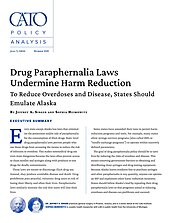These laws are meant to discourage illicit drug use. Instead, they produce avoidable disease and death. Drug prohibition puts peaceful, voluntary drug users at risk of losing their liberty and often their lives. Paraphernalia laws similarly increase the risk that users will lose their lives.
Some states have amended their laws to permit harm-reduction programs and tools. For example, many states allow syringe services programs (also called SSPs or “needle exchange programs”) to operate within narrowly defined parameters.
The goal of drug paraphernalia policy should be to save lives by reducing the risks of overdose and disease. This means removing government barriers to obtaining and distributing clean syringes and drug testing equipment. Because Alaska leaves residents free to purchase syringes and other paraphernalia in any quantity, anyone can operate an SSP and implement other harm-reduction measures. States should follow Alaska’s lead by repealing their drug paraphernalia laws so that programs aimed at reducing overdoses and disease can proliferate and succeed.





